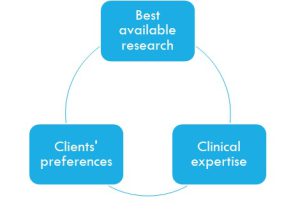A Guide to Evidence-Based Practice for Caregivers

You may have heard the term ‘evidence-based’ when talking with a medical professional or allied health provider. The phrase is often used during the selection of an intervention but what does ‘evidence-based’ or ‘evidence-based practice’ really mean?
1. What is evidence-based practice?
The American Psychological Association (2006) has defined evidence-based practice in psychology as “…the integration of the best available research with clinical expertise in the context of patient characteristics, culture, and preferences” (p. 273). In simpler terms, evidence-based practice means that a clinician must use:
1. Best available research
2. Their own clinical expertise and
3. Clients’ individual preferences
2. How do I know if my child’s clinician is using evidence-based practice?
Clinical expertise is generally defined as a combination of both practical and theoretical knowledge (Benner, 1984). In other words, a clinician’s educational background, licensures, and certificates combined with hands-on field experience gives a clinician their sense of clinical expertise or ability to make decisions in the best interest of their clients.
A client’s preferences can typically be found by talking to the client or their caregivers about their likes and dislikes, formally observing and recording reactions to various items and activities (e.g., a preference assessment), and discussing all interventions with client’s and caregivers before implementation.
To ensure clinicians in the autism and disability sector are using ‘best available evidence, the research must have assessed specific interventions and categorised them into the following categories: empirically supported treatments (ESTs), emerging treatments, or unsupported interventions. According to the American Psychological Association (2006). ESTs are specific interventions demonstrated to be effective via rigorous studies (e.g., randomised control trials showing positive effects).
To summarise, a clinician should be relying on their academic knowledge and experience, a client’s preferences, and empirically supported treatments to make clinical decisions regarding client goals and the methods of achieving those goals. If a clinician can provide evidence of these three components in their clinical work, they are using evidence-based practice.
3. Who decides which interventions are evidence based?
The most recent review of intervention effectiveness in the autism and disability sector was conducted by the National Clearinghouse on Autism Evidence and Practice (NCAEP; 2020) and before that, publications by both the National Autism Centre (2015) and Wong et al. (2015) were the most recent categorisations. Links to all three of these reports can be found below:
NAC, 2015: https://nationalautismcenter.org/national-standards-project/phase-2/
4. Why does it matter?
It’s common to think ‘What’s the harm?’ when looking into new therapies and interventions that claim to help, even if these methods aren’t listed as an evidence-based treatment. This is especially true when the interventions claim to be based on science by advocates of the treatment, appear to cost less in terms of money, time, and resources and may be presented as a cure or quick fix (Smith, 2015). If it seems too good to be true, it probably is!
Unfortunately, unsupported treatments may be ineffective or in some cases, even harmful. Implementing unsupported treatments may have significant hidden costs, such as time, hidden financial arrangements and resources that could be better allocated to ESTs. Pursuing unsupported treatments for very young children with autism spectrum disorder may be particularly problematic, since such treatments waste substantial and critical time in the life of a child with autism (Foxx, 2008). While unsupported interventions may seem appealing at first glance, it is important to only use those strategies that have undergone rigorous study to best protect clients and loved ones from these potentially harmful outcomes and to support them to have the best chance of positive outcomes.
Published On : June 20, 2022
Read more
Published On : June 20, 2022
If you suspect your child has autism spectrum disorder (ASD), your journey to understanding your child’s health challenges may include an autism spectrum test.
Published On : July 4, 2022
If you suspect your child has autism spectrum disorder (ASD), your journey to understanding your child’s health challenges may include an autism spectrum test.



